MSI P35 Neo2-FR: Platinum performance for under $100
by Gary Key on December 5, 2007 11:00 PM EST- Posted in
- Motherboards
MSI P35 Neo2-FR: Board Layout and Features
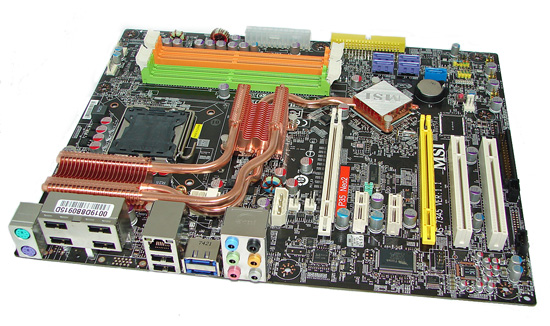 |
MSI devised a new heatpipe system for this series of boards to replace the rollercoaster version on the Platinum boards. Frankly, we certainly think it looks better and cooling performance remains roughly equal. The color scheme is awkward, with various neon colors sitting atop an otherwise elegant black PCB, but appearance probably isn't at the top of the list of important considerations when discussing sub-$100 motherboards. The board was a snap to install in our Antec P180 and Cooler Master 830 cases with most connections easily reached. The Neo2-FR board features a high quality four-phase voltage regulator system that provided excellent stability throughout testing. The board also utilizes Conductive Polymer Aluminum Solid Capacitors.
The MSI P35 Neo2-FR comes with six fan headers (1 x 4-pin, 5 x 3-pin) that provide an excellent balance of cooling options. However, there are limited control options in both the BIOS and MSI's Dual Core Center program. The BIOS controls are limited to percentage based fan speed controls for the CPU and Northbridge fan headers. The Dual Core Center allows changes that are more extensive but are still percentage based. The DCC also allows fan speed monitoring for two system fan headers. This is one of the biggest weaknesses of the board. We wish all manufacturers would design a decent set of applications that match or exceed abit's µGuru technology. Otherwise, we are going to continue to deduct points from manufacturers in this area.
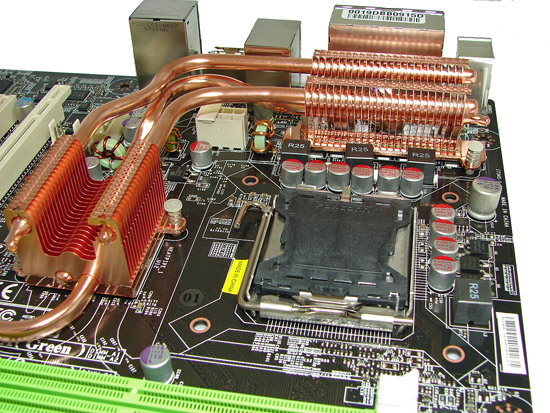 |
Around the CPU socket, we find an ample amount of room for the majority of cooling solutions. We utilized the stock heatsink/fan in our base testing and it worked fine. We also installed several aftermarket Socket-775 cooling solutions such as the Tuniq 120 and Thermalright Ultra-120 eXtreme during our overclocking tests without a problem. However, based upon our initial overclocking tests, if you use a vertical mounted fan with an air cooler (i.e. Tuniq 120) or water-cooling then additional air-cooling will be required on the MCH and PWM areas. In other words, the heatpipe system requires additional fan cooling or the use of a downward blowing CPU HSF fan.
The 8-pin ATX power connector is located in between the heatpipe system. It was easy to our install our power cable but difficult to remove. MSI does include an adapter but we preferred not to use it. We removed the heatpipe system easily to test water-cooling on the MCH/ICH chipsets.

The DIMM module slots' color coordination is not correct for dual channel setup based upon the premise of installing DIMMs in the same colored slots for dual-channel operation. MSI continues to use this coordination scheme, for reasons unknown. The green slots are Channel A and the orange slots are Channel B, and dual-channel requires installing one or two DIMMs into each channel. Installing memory modules with a full size video card placed in the first PCI Express x16 slot was not a problem. The 24-pin ATX power connector is located on the edge of the board along with the number three system fan header.
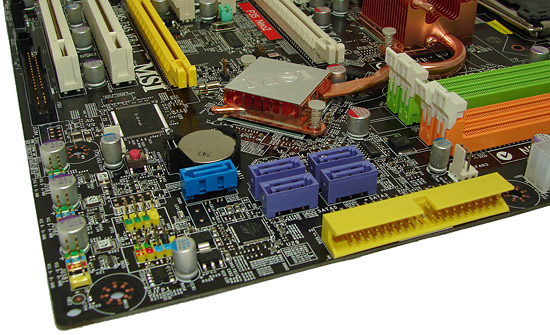
We found the positioning of the four purple ICH9R SATA ports to be excellent when utilizing the expansion slots, as they are out of the way of longer cards. However, a full-size card located in the second PCI Express x16 (physical) slot will partially block the light-blue SATA slot. The passively cooled ICH9R chipset remained cool to the touch throughout testing. The IDE connector is located below the SATA ports.
MSI added a red clear CMOS button on the board. Of interest, MSI has a series of LED lights in the same location that take the place of the typical POST Code Debug display. The user can decipher the error sequences displayed by the led panel by looking in the manual, though with four lights they are limited to sixteen codes. Personally, we prefer the standard debug displays, but for the price we can't really complain.
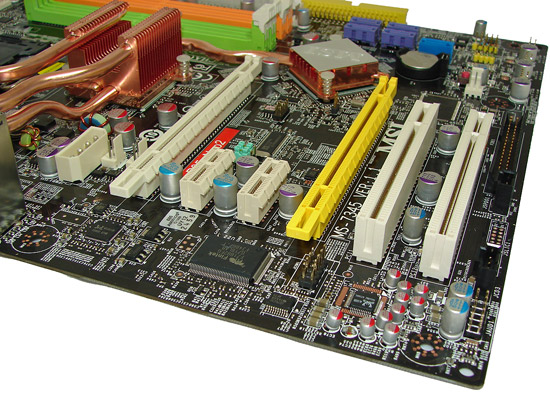
The board comes with two physical PCI Express x16 connectors (1 x16, 1 x4 electrical), two PCI Express x1 connectors, and two PCI 2.3 connectors. Dual-slot graphics cards will block the first PCI Express and PCI slots. A 4-pin 12V Molex connector is to the left of the first PCI Express x16 slot for CrossFire operation; MSI also recommends using the additional power connection if all of the expansion slots are populated. MSI includes a set of jumpers that allows the user to set the FSB rates at 200, 266, and 333.
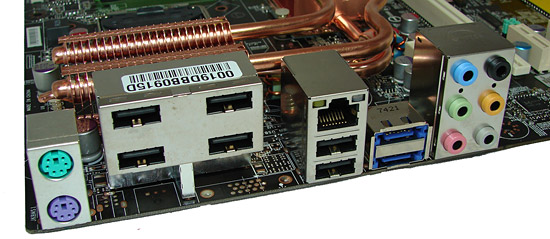
The rear panel contains the standard PS/2 mouse and keyboard ports. The panel also includes an RJ-45 LAN port with activity indicator lights, six USB ports, and two eSATA ports. The audio panel consists of six ports that support 2, 4, 6, and 8-channel audio connections for the Realtek ALC888T HD codec.










35 Comments
View All Comments
drebo - Friday, December 7, 2007 - link
I'll forgive your ignorant comment since you obviously do not work in retail computer sales. People aren't interested in buying adapters and add-on cards that they don't feel they should need because "their old computer had it." In a managed IT environment, yes, you can just give everyone converters and it works fine, but your average joe who walks into a computer shop with a 10-year-old dead computer and an ancient Epson parallel printer isn't ever going to understand why his old connections are going by the way-side.So, yes, legacy support in the retail market is important, even for most small business users. Not a day doesn't go by when I get a call or someone comes in needing a parallel card or serial card because the off-the-shelf computer they bought doesn't come with one. Most people don't need 16 USB ports, but I'll bet a good number do need a parallel port.
AssBall - Saturday, December 8, 2007 - link
"I'll forgive your ignorant comment since you obviously do not work in retail computer sales."Right... because a good retail computer salesperson would sell someone who is inexperienced enough to not RTFM a 10$ adapter instead of reccomending a better and higher profit margin 10 year newer replacement product for 150$ with built in factory support$
Salesman indeed...
kmmatney - Thursday, December 6, 2007 - link
Serial mice? Come-on! I used serial mice back in the day, but there is absolutely no need to get a USB mouse - I just bought a spare optical mouse for $3 at Microcenter - works great. You can get a USB-RS232 adapter for around $15 as well. Or you can buy a PCI add-on card, with RS232 and Parallel ports, for around the same price. I'd way rather have the extra USB and e-Sata ports instead of the legacy crap.I do a lot of RS-232 and RS-485 programming, and my main computer is a laptop, so I've been using USB-Serial converters for some time now.
theslug - Thursday, December 6, 2007 - link
They sell these:http://www.newegg.com/Product/ProductList.aspx?Sub...">http://www.newegg.com/Product/ProductLi...iption=u...
OndrejSc - Thursday, December 6, 2007 - link
Cheer up! It does exist. :-)http://global.msi.com.tw/index.php?func=proddesc&a...">http://global.msi.com.tw/index.php?func...=1342&am...
drebo - Thursday, December 6, 2007 - link
Hmmm, good news. I wonder when we'll have availability and what the pricing will be like.LoneWolf15 - Thursday, December 6, 2007 - link
"MSI also offers the Creative Lab's X-Fi audio codecs on their high-end boards as a nod to the gaming community."No...MSI puts the X-Fi XtremeAudio chip on the boards, which is a tweaked Audigy SE chip (note: the Audigy SE isn't even a true Audigy chip), not a true X-Fi. No hardware EAX or DirectSound3D acceleration, and the drivers, like the X-Fi XtremeAudio card, are completely different than the rest of the X-Fi line. So, serious gamers STILL need to buy a sound card.
I really like MSI and use their boards a lot, but this audio solution is really only slightly better than what is used on other boards --and those who don't like Creative might argue that the drivers actually make it worse. If MSI had used the real X-Fi chip, I'd be very impressed.
ultimatex - Thursday, December 6, 2007 - link
are u retarted ? serious gamers need to buy a seperate sound card? A real serious games would not be worrying about some sound options but more about performace of the board. I smell some Asus Gybabyte fan boys here on these forums.as long as boards have 5.1 sound U dont need no special features that dont do anything specialy for games. Serious games wear headphones.
these NERDS here are sounding like if a serious gamer has to have a sound card . Well ill tell u from a X-Cal P Css Player here. A videocard and Fps is the most important thing for a Hardcore gamer..
Etern205 - Friday, December 7, 2007 - link
Your the retarded one.If he's right and that the onboard X-FI does not have hardware accelerated audio, what it means it it uses the cpu to process the audio singal which leads to reduce FPS. Gamers needs to know where their enemies are and that's where the EAX comes in. Onboard will have EAX as well as mutli-channel speaker support (ie 5.1 surround sound) but without a higher version of EAX (ie EAX 5.0) all your hearing are just sounds coming at you with no sense of direction.
So if you got a 5.1 speaker setup but with a crappy onboard Audio or onboard X-FI with crappy EAX support then it won't help you as much as a dedicated sound card.
dazy - Tuesday, December 11, 2007 - link
Thanks for pointing out his utter ignorance before I had to, lol.[quote=ultimatex]serious gamers need to buy a seperate sound card?
as long as boards have 5.1 sound U dont need no special features that dont do anything specialy for games. Serious games wear headphones.
A videocard and Fps is the most important thing for a Hardcore gamer..[/quote]
The sheer number of stupid statements for a "gamer" in his post is outstanding. Maybe he thinks we are talking about his XBOX360? ;-)